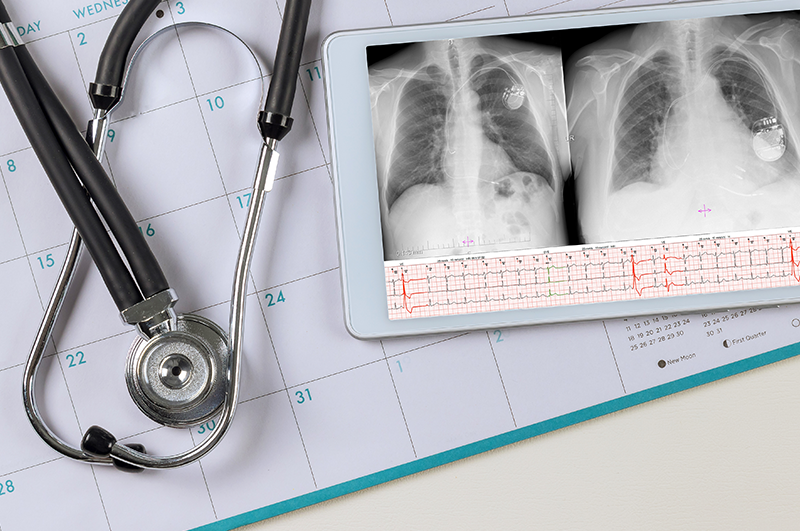Defibrillators vs. Pacemakers: What's the Difference?
August 22, 2022

Defibrillators and pacemakers are similar in many ways. For example, both are
implantable medical devices that help treat irregular heart rhythms, or arrhythmias, in which the heart beats too quickly, too slowly, or irregularly. Both devices improve the quality of life for patients with arrhythmias. An irregular heartbeat can cause fatigue or weakness, lightheadedness, dizziness, fainting, pounding in the chest, rapid heartbeat, shortness of breath, and even chest pain or pressure. Pacemakers and defibrillators perform different functions, but these differences are important.
What is a Defibrillator?
A defibrillator delivers a shock of electricity to the heart to help restore a standard heart rate in a patient whose heart is beating either too quickly or too slowly. These devices may also convert a regular heart rate if the person has a
sudden cardiac arrest (SCA), a condition in which the patient’s heart stops beating. An SCA can happen when an electrical malfunction in the individual’s heart causes an irregular heartbeat that prevents the heart from pumping blood to the brain, lungs, and rest of the body.
Three Main Types of Defibrillators That Are Available Today:
• Implantable cardioverter defibrillator (ICD) – A device a surgeon implants inside the patient’s body.
• Wearable cardioverter defibrillator (WCD) – Has sensors that attach to the skin, monitor heart rhythm, and deliver an electric shock to restore a normal heartbeat (if needed).
• Automated external defibrillator (AED) – Can be found throughout various workplaces and public spaces, and bystanders can use AEDs in emergencies where someone has experienced a cardiac arrest.
You can usually find
AEDs in public places. The
American Heart Association says defibrillators should be in every public place where there is a high risk that someone will have a cardiac arrest.
For those prone to cardiac arrest, cardiac surgeons can perform minor surgical procedures to place ICDs, usually using local anesthesia rather than general anesthesia. They make a small incision to place the ICD, typically in the patient’s breastbone, along their ribs, or thread them through blood vessels to the patient’s heart.
What is a Pacemaker?
A pacemaker is an electronic device that keeps the heart working at a normal rate and steady rhythm by sending low-energy shocks to the heart. Doctors refer to the speed at which pacemakers deliver these shocks as the “pacing rate.”
Cardiac surgeons place a pacemaker inside the body, usually in the patient’s shoulder; wires lead from the pacemaker to the patient’s heart. To place a pacemaker, the surgeon uses X-rays or echocardiography to guide the leads through veins in the patient’s neck, chest, or thigh through to the chambers of the patient’s heart.
Advances in
medical technology have allowed manufacturers to shrink pacemakers so that the devices are small enough for implantation directly onto the heart muscle.
As with ICD defibrillators, pacemakers feature special sensors that track heart rhythm and respond accordingly. If the person’s heart is beating too slowly, the pacemaker will send electric shocks to help return the heart rate to normal.
Some newer ICD models include a pacemaker function that keeps the heart beating at a healthy rate and rhythm.
Who Needs a Defibrillator?
People who are having cardiac arrest or who are experiencing sudden arrhythmias may need a defibrillator. Those who have heart failure, are awaiting a heart transplant, or a heart disease known as cardiomyopathy may benefit from an ICD.
Who Needs a Pacemaker?
Pacemakers are for people who have arrhythmias due to certain structural problems of the heart, issues with the heart’s electrical signaling pathways, specific types of muscular dystrophy, or
heart attacks.
Key Differences Between a Pacemaker and Defibrillator
While both electronic devices can improve the quality of life and even save lives, there are critical differences between a pacemaker and a defibrillator. For example, a pacemaker uses ongoing low-energy electric shocks to keep the heart beating in a regular rhythm. At the same time, a defibrillator
monitors heart rate and delivers a strong electrical shock only when the heartbeat is dangerously irregular.
For more information about defibrillators or pacemakers, consult with your doctor, cardiologist, or a trusted defibrillator maker like
Defibtech.
